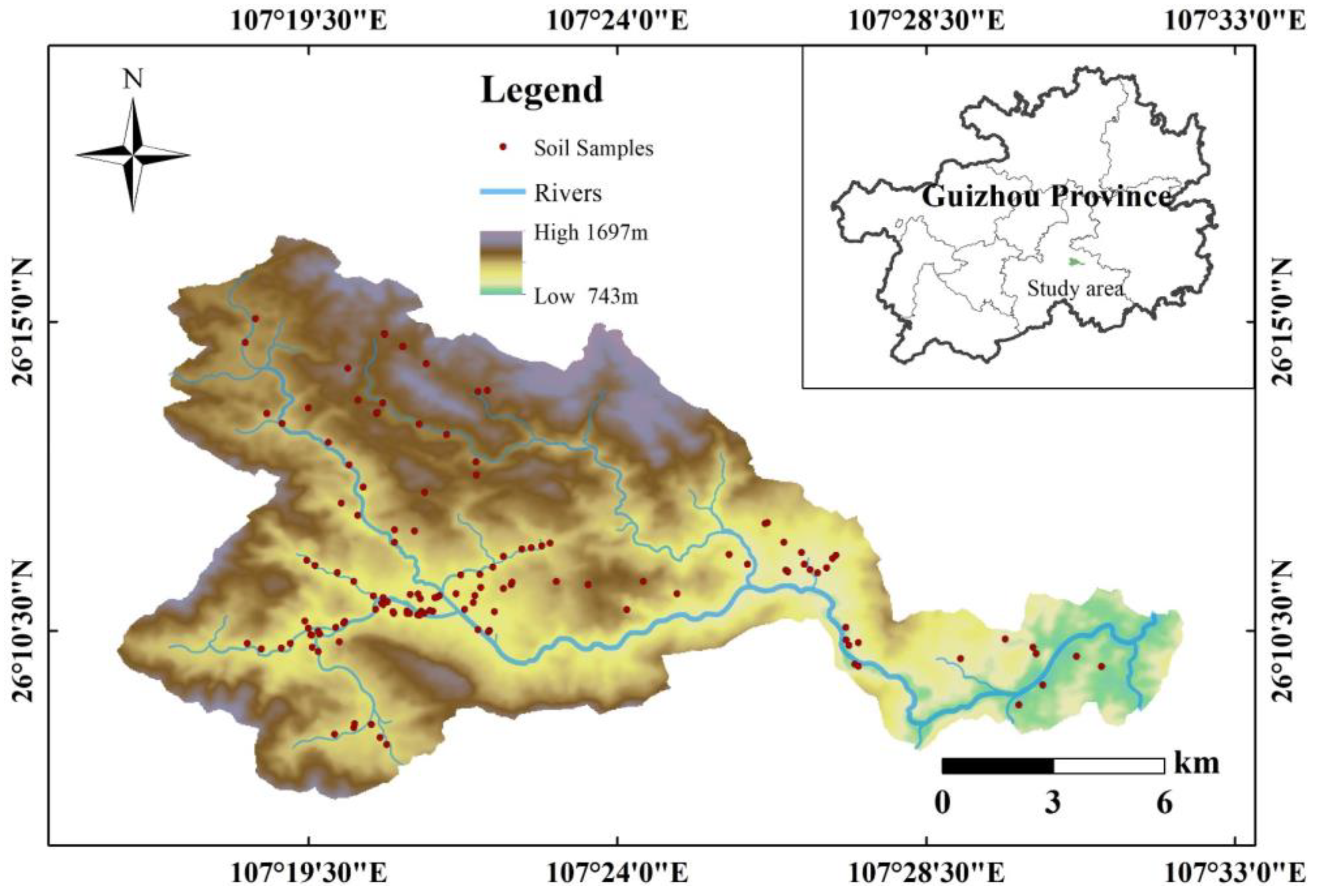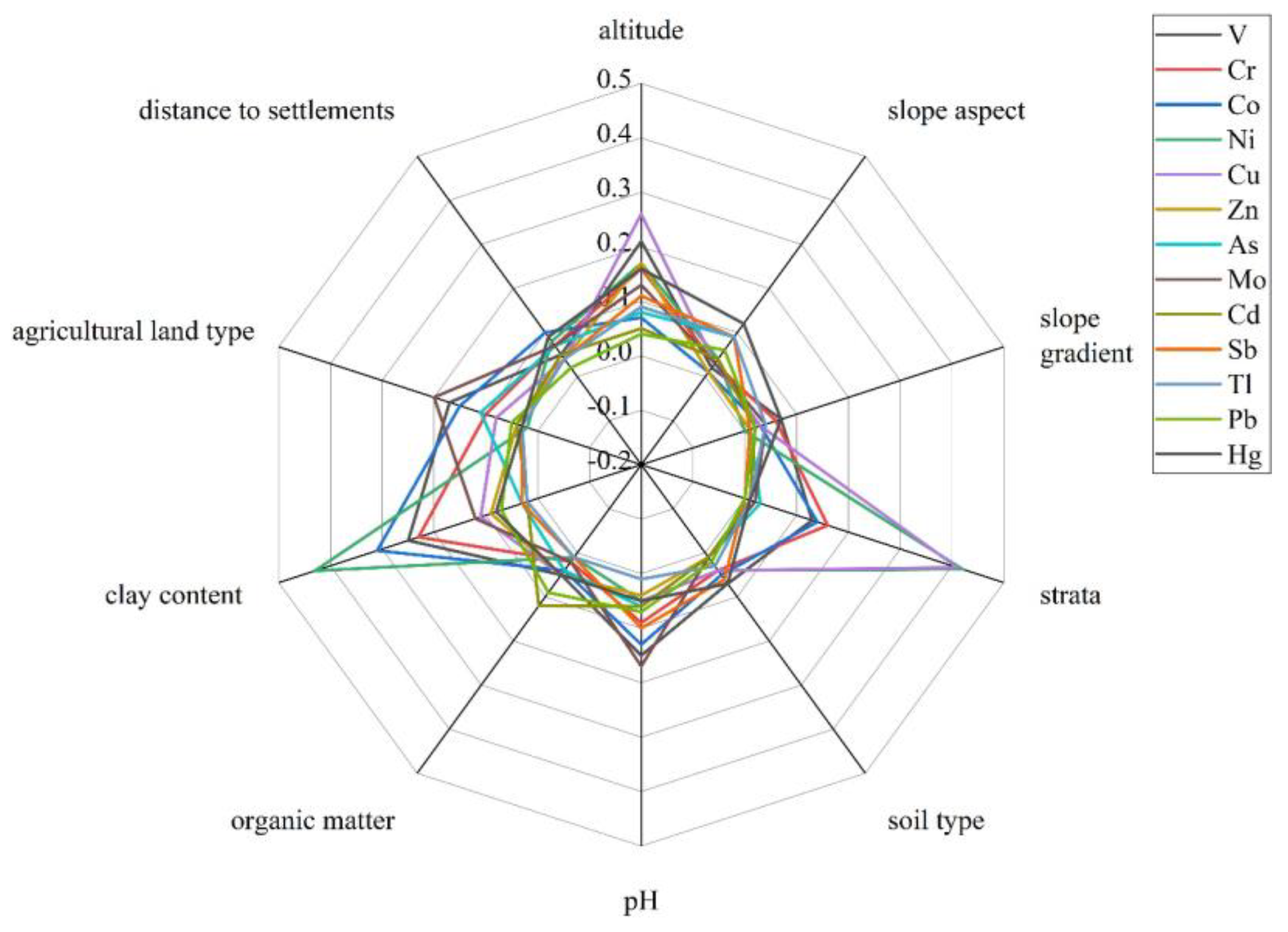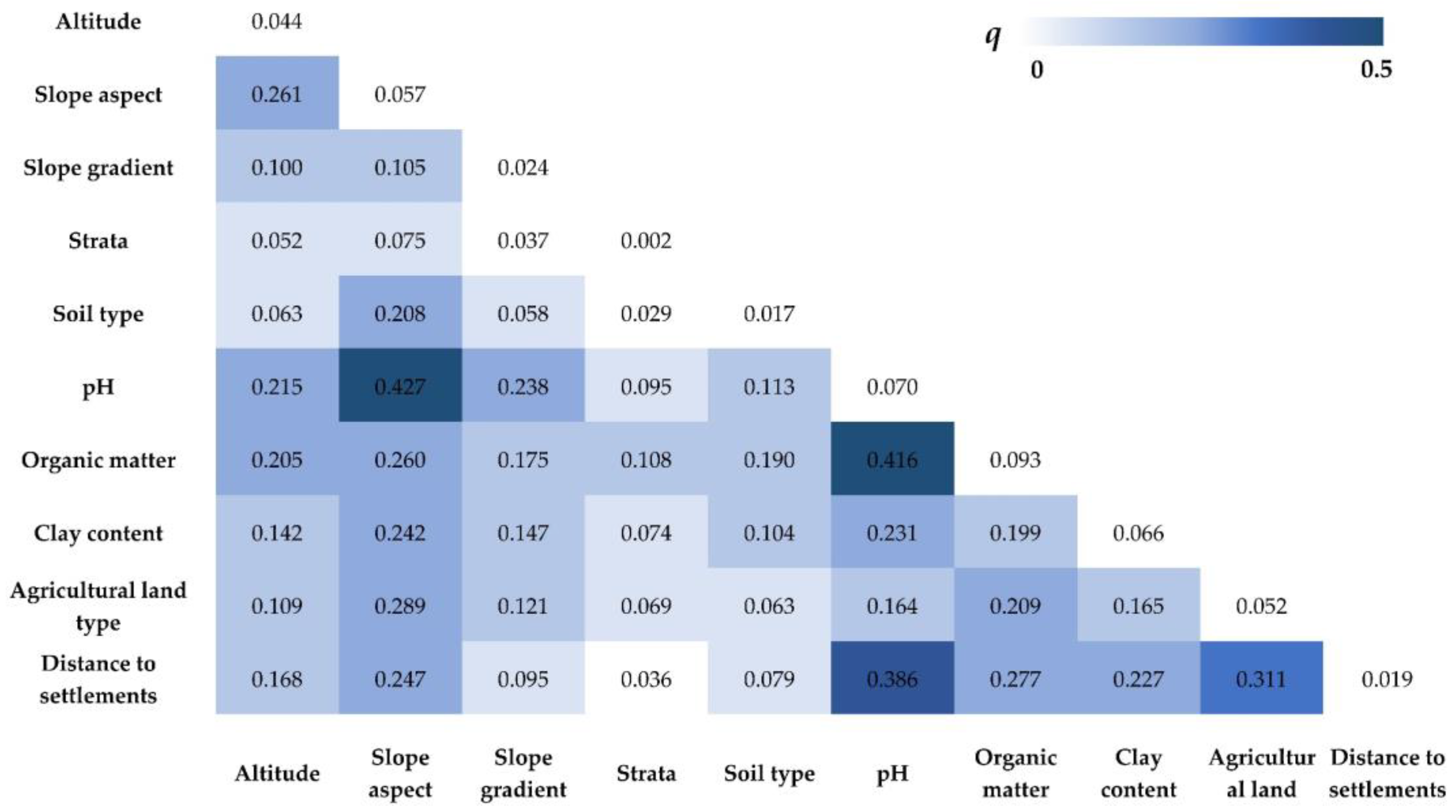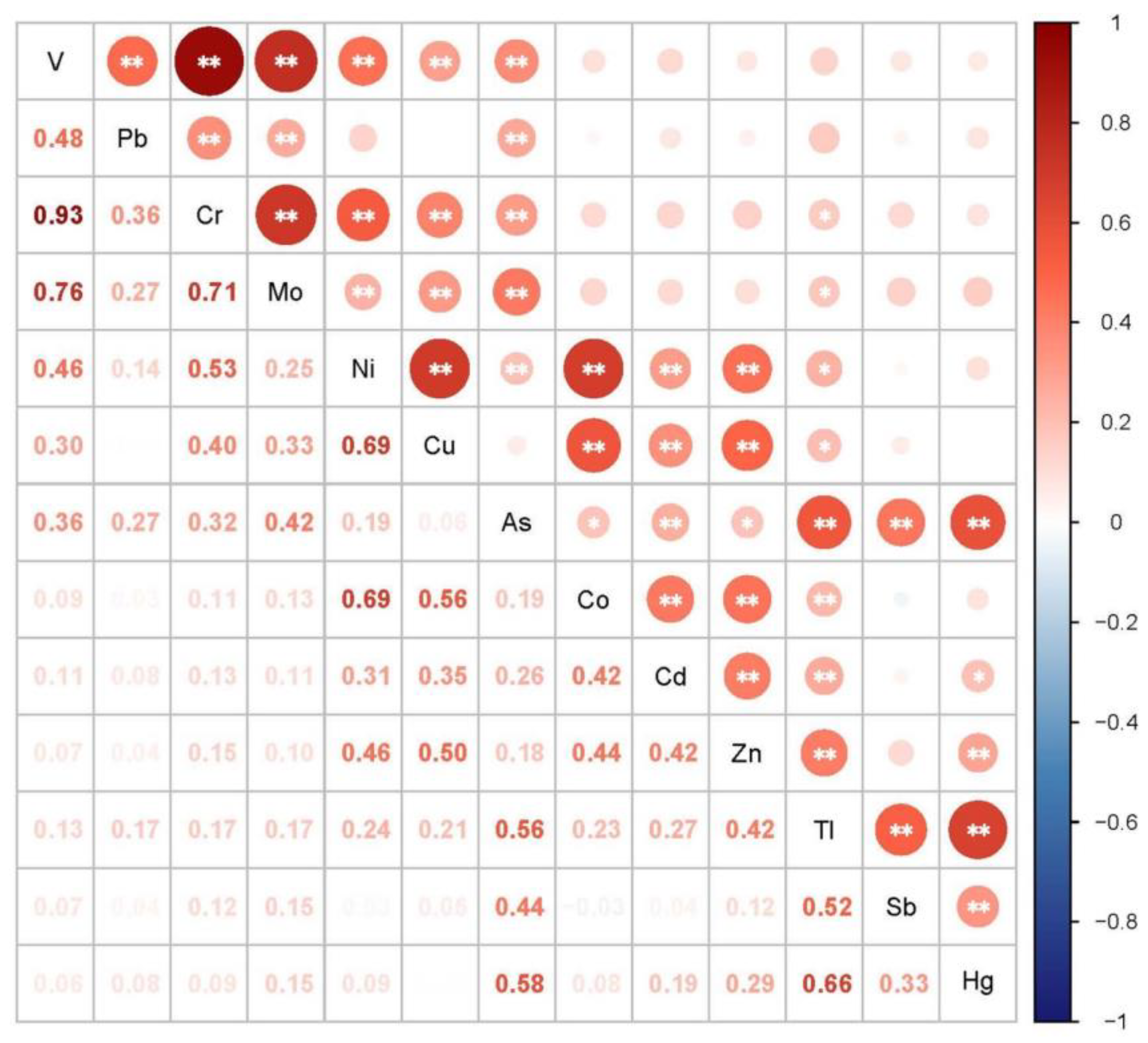Natural Factors on Heterogenetic Accumulations of PTEs in Sloping Farmland in a Typical Small Mountainous Watershed in Southwest China
Abstract
:1. Introduction
2. Materials and Methods
2.1. Study Area and Sampling
2.2. Laboratory Analysis
2.3. Quality Control
2.4. Statistical Methods
3. Results and Discussion
3.1. Physicochemical Properties of Soil Samples
3.2. Content of PTEs in Soil
3.3. Influencing Factors of PTE Distribution in the Soil
3.3.1. Selection and Stratification of Impact Factors
3.3.2. Factor Detector
3.3.3. The Interaction of the Detector Results
3.4. Source Analysis of PTEs
4. Conclusions
- (1)
- In this study, we studied the distribution of 13 PTEs in sloping farmland soils collected from a mountainous watershed in Guizhou Province, Southwest China. All of the PTEs were unevenly distributed, especially Sb. The proportion of samples with Cd, Hg and As exceeding the screening value of the soil pollution risk of agricultural land in China was 46.7%, 5.9% and 4.4%, respectively.
- (2)
- The results of the factor detector showed that the factor of altitude contributed a lot to the 13 PTEs, indicating that the spatial distribution may be impacted by the local pedogenesis process. In addition, the stratigraphic factors contributed greatly to the distribution of Co, Ni and Cu, which implied their similarity in the parental material.
- (3)
- The interaction of the detector results showed that V, Cr, Mo and Pb are affected by the nonlinear interaction result from the combined effect of clay content, altitude and agricultural land type.
- (4)
- Based on the results of the geographic detectors and multivariate statistical analysis, V, Cr, Mo and Pb were significantly correlated in pairs, indicating that the sources of the four PTEs were similar and might be affected by natural factors and agricultural activities. Co, Ni, Cu, Zn and Cd were mainly affected by natural sources, and their migration and enrichment may be influenced by the combined action of both regional geology and altitude factors. Furthermore, the distribution of As, Sb, Tl and Hg was associated with potential sources of mercury ore, and As may also be affected by local agricultural activities.
Supplementary Materials
Author Contributions
Funding
Acknowledgments
Conflicts of Interest
References
- Zhang, Q.; Wang, C. Natural and human factors affect the distribution of soil heavy metal pollution: A review. Water Air Soil Pollut. 2020, 231, 350. [Google Scholar] [CrossRef]
- Mamat, Z.; Yimit, H.; Ji, R.Z.A.; Eziz, M. Source identification and hazardous risk delineation of heavy metal contamination in Yanqi basin, northwest China. Sci. Total Environ. 2014, 493, 1098–1111. [Google Scholar] [CrossRef] [PubMed]
- Wang, Q.; Xie, Z.; Li, F. Using ensemble models to identify and apportion heavy metal pollution sources in agricultural soils on a local scale. Environ. Pollut. 2015, 206, 227–235. [Google Scholar] [CrossRef] [PubMed]
- Wu, Q.; Hu, W.; Wang, H.; Liu, P.; Wang, X.; Huang, B. Spatial distribution, ecological risk and sources of heavy metals in soils from a typical economic development area, Southeastern China. Sci. Total Environ. 2021, 780, 146557. [Google Scholar] [CrossRef] [PubMed]
- Karim, Z.; Qureshi, B.A.; Mumtaz, M. Geochemical baseline determination and pollution assessment of heavy metals in urban soils of Karachi, Pakistan. Ecol. Indic. 2015, 48, 358–364. [Google Scholar] [CrossRef]
- Fazekašová, D.; Petrovič, F.; Fazekaš, J.; Štofejová, L.; Baláž, I.; Tulis, F.; Tóth, T. Soil Contamination in the Problem Areas of Agrarian Slovakia. Land 2021, 10, 1248. [Google Scholar] [CrossRef]
- Ding, Q.; Cheng, G.; Wang, Y.; Zhuang, D. Effects of natural factors on the spatial distribution of heavy metals in soils surrounding mining regions. Sci. Total Environ. 2017, 578, 577–585. [Google Scholar] [CrossRef]
- Xu, L.; Wang, T.; Luo, W.; Ni, K.; Liu, S.; Wang, L.; Li, Q.; Lu, Y. Factors influencing the contents of metals and As in soils around the watershed of Guanting Reservoir, China. J. Environ. Sci. 2013, 25, 561–568. [Google Scholar] [CrossRef]
- Qiu, S.; Zhu, Z.; Yang, T.; Wu, Y.; Bai, Y.; Ouyang, T. Chemical weathering of monsoonal eastern China: Implications from major elements of topsoil. J. Asian Earth Sci. 2014, 81, 77–90. [Google Scholar] [CrossRef]
- Lv, J. Multivariate receptor models and robust geostatistics to estimate source apportionment of heavy metals in soils. Environ. Pollut. 2019, 244, 72–83. [Google Scholar] [CrossRef]
- Kong, X.; Liu, T.; Yu, Z.; Chen, Z.; Lei, D.; Wang, Z.; Zhang, H.; Li, Q.H.; Zhang, S.S. Heavy metal bioaccumulation in rice from a high geological background area in Guizhou Province, China. Int. J. Environ. Res. Public Health 2018, 15, 2281. [Google Scholar] [CrossRef] [PubMed] [Green Version]
- Li, B.; Zhuang, X.; Li, J.; Querol, X.; Font, O.; Moreno, N. Geological controls on mineralogy and geochemistry of the Late Permian coals in the Liulong Mine of the Liuzhi Coalfield, Guizhou Province, Southwest China. Int. J. Coal Geol. 2016, 154, 1–15. [Google Scholar] [CrossRef]
- Argüello, D.; Chavez, E.; Lauryssen, F.; Vanderschueren, R.; Smolders, E.; Montalvo, D. Soil properties and agronomic factors affecting cadmium concentrations in cacao beans: A nationwide survey in Ecuador. Sci. Total Environ. 2019, 649, 120–127. [Google Scholar] [CrossRef] [PubMed]
- Kanellopoulos, C.; Argyraki, A.; Mitropoulos, P. Geochemistry of serpentine agricultural soil and associated groundwater chemistry and vegetation in the area of Atalanti, Greece. J. Geochem. Explor. 2015, 158, 22–33. [Google Scholar] [CrossRef]
- Oze, C.; Fendorf, S.; Bird, D.K.; Coleman, R.G. Chromium geochemistry in serpentinized ultramafic rocks and serpentine soils from the Franciscan complex of California. Am. J. Sci. 2004, 304, 67–101. [Google Scholar] [CrossRef]
- Bini, C.; Maleci, L.; Wahsha, M. Potentially toxic elements in serpentine soils and plants from Tuscany (Central Italy). A proxy for soil remediation. Catena 2017, 148, 60–66. [Google Scholar] [CrossRef]
- China Geological Survey. Geochemical Survey of Cultivated Land in China; CGS: Beijing, China, 2015. [Google Scholar]
- Yang, Q.; Yang, Z.; Zhang, Q.; Ji, W.; Guan, D.X.; Liu, X.; Yu, T.; Wang, L.; Zhuo, X.; Ji, J. Transferability of heavy metal(loid)s from karstic soils with high geochemical background to peanut seeds. Environ. Pollut. 2022, 299, 118819. [Google Scholar] [CrossRef]
- Shetaya, W.H.; Marzouk, E.R.; Mohamed, E.F.; Elkassas, M.; Bailey, E.H.; Young, S.D. Lead in Egyptian soils: Origin, reactivity and bioavailability measured by stable isotope dilution. Sci. Total Environ. 2018, 618, 460–468. [Google Scholar] [CrossRef]
- Dong, S.; Pan, Y.; Guo, H.; Gao, B.; Li, M. Identifying Influencing Factors of Agricultural Soil Heavy Metals Using a Geographical Detector: A Case Study in Shunyi District, China. Land 2021, 10, 1010. [Google Scholar] [CrossRef]
- Gao, Y.; Li, F.; Mao, L.; Gu, B.; Peng, C.; Yang, Q.; Lu, L.; Chen, X.; Zhang, D.; Tao, H. Potential Loss of Toxic Elements from Slope Arable Soil Erosion into Watershed in Southwest China: Effect of Spatial Distribution and Land-Uses. Minerals 2021, 11, 1422. [Google Scholar] [CrossRef]
- Li, Y.; Wang, S.; Nan, Z.; Zang, F.; Sun, H.; Zhang, Q.; Huang, W.; Bao, L. Accumulation, fractionation and health risk assessment of fluoride and heavy metals in soil-crop systems in northwest China. Sci. Total Environ. 2019, 663, 307–314. [Google Scholar] [CrossRef] [PubMed]
- Le Dinh, H.; Shibata, M.; Kohmoto, Y.; Ho, L.N.; Funakawa, S. Analysis of the processes that generate surface runoff and soil erosion using a short-term water budget on a mountainous sloping cropland in central Vietnam. Catena 2022, 211, 106032. [Google Scholar] [CrossRef]
- Cheng, Y.; Li, P.; Xu, G.; Li, Z.; Gao, H.; Zhao, B.; Wang, T.; Wang, F.; Cheng, S. Effects of soil erosion and land use on spatial distribution of soil total phosphorus in a small watershed on the Loess Plateau, China. Soil Tillage Res. 2018, 184, 142–152. [Google Scholar] [CrossRef]
- Martín, J.A.R.; Arias, M.L.; Corbí, J.M.G. Heavy metals contents in agricultural topsoils in the Ebro basin (Spain). Application of the multivariate geoestatistical methods to study spatial variations. Environ. Pollut. 2007, 144, 1001–1012. [Google Scholar] [CrossRef]
- Guo, X.; Zhao, Y.; He, H.; Wang, X. Potential ecological risk assessment of soil heavy metals in Hunchun basin, Northeast China. Arab. J. Geosci. 2020, 13, 56. [Google Scholar] [CrossRef]
- Yang, J.; Wang, J.; Qiao, P.; Zheng, Y.; Yang, J.; Chen, T.; Lei, M.; Wan, X.; Zhou, X. Identifying factors that influence soil heavy metals by using categorical regression analysis: A case study in Beijing, China. Front. Environ. Sci. Eng. 2020, 14, 37. [Google Scholar] [CrossRef]
- Hou, D.; O’Connor, D.; Nathanail, P.; Tian, L.; Ma, Y. Integrated GIS and multivariate statistical analysis for regional scale assessment of heavy metal soil contamination: A critical review. Environ. Pollut. 2017, 231, 1188–1200. [Google Scholar] [CrossRef]
- Jamil, M.; Malook, I.; Rehman, S.U.; Khan, M.D.; Fayyaz, M.; Aslam, M.M.; Rha, E.S. Multivariate geo-statistical perspective: Evaluation of agricultural soil contaminated by industrial estate’s effluents. Environ. Geochem. Health 2022, 44, 57–68. [Google Scholar] [CrossRef]
- Dragović, R.; Gajić, B.; Dragović, S.; Đorđević, M.; Đorđević, M.; Mihailović, N.; Onjia, A. Assessment of the impact of geographical factors on the spatial distribution of heavy metals in soils around the steel production facility in Smederevo (Serbia). J. Clean. Prod. 2014, 84, 550–562. [Google Scholar] [CrossRef]
- Qiao, P.; Yang, S.; Lei, M.; Chen, T.; Dong, N. Quantitative analysis of the factors influencing spatial distribution of soil heavy metals based on geographical detector. Sci. Total Environ. 2019, 664, 392–413. [Google Scholar] [CrossRef]
- Fan, H.; Chen, S.; Li, Z.; Liu, P.; Xu, C.; Yang, X. Assessment of heavy metals in water, sediment and shellfish organisms in typical areas of the Yangtze River Estuary, China. Mar. Pollut. Bull. 2020, 151, 110864. [Google Scholar] [CrossRef] [PubMed]
- Huang, S.; Xiao, L.; Zhang, Y.; Wang, L.; Tang, L. Interactive effects of natural and anthropogenic factors on heterogenetic accumulations of heavy metals in surface soils through geodetector analysis. Sci. Total Environ. 2021, 789, 147937. [Google Scholar] [CrossRef] [PubMed]
- Wang, J.; Li, X.; Christakos, G.; Liao, Y.; Zhang, T.; Gu, X.; Zheng, X. Geographical Detectors-Based Health Risk Assessment and its Application in the Neural Tube Defects Study of the Heshun Region, China. Int. J. Geogr. Inf. Sci. 2010, 24, 107–127. [Google Scholar] [CrossRef]
- Su, Y.; Li, T.; Cheng, S.; Wang, X. Spatial distribution exploration and driving factor identification for soil salinisation based on geodetector models in coastal area. Ecol. Eng. 2020, 156, 105961. [Google Scholar] [CrossRef]
- Du, Z.; Gao, B.; Ou, C.; Du, Z.; Yang, J.; Batsaikhan, B.; Dorjgotov, B.; Yun, W.; Zhu, D. A quantitative analysis of factors influencing organic matter concentration in the topsoil of black soil in northeast China based on spatial heterogeneous patterns. ISPRS Int. J. Geo-Inf. 2021, 10, 348. [Google Scholar] [CrossRef]
- Yan, P.; Shen, C.; Fan, L.; Li, X.; Zhang, L.; Zhang, L.; Han, W. Tea planting affects soil acidification and nitrogen and phosphorus distribution in soil. Agr. Ecosyst. Environ. 2018, 254, 20–25. [Google Scholar] [CrossRef]
- Hui, W.; Ren-Kou, X.; Ning, W.; Xing-Hui, L. Soil acidification of Alfisols as influenced by tea cultivation in eastern China. Pedosphere 2010, 20, 799–806. [Google Scholar]
- Reimann, C.; Fabian, K.; Birke, M.; Filzmoser, P.; Demetriades, A.; Négrel, P.; Sadeghi, M. GEMAS: Establishing geochemical background and threshold for 53 chemical elements in European agricultural soil. Appl. Geochem. 2018, 88, 302–318. [Google Scholar] [CrossRef] [Green Version]
- Burt, R.; Wilson, M.A.; Mays, M.D.; Lee, C.W. Major and trace elements of selected pedons in the USA. J. Environ. Qual. 2003, 32, 2109–2121. [Google Scholar] [CrossRef] [PubMed]
- CNEMC (China National Environmental Monitoring Center). The Soil Background Value in China; China Environmental Science Press: Beijing, China, 1990. [Google Scholar]
- Yang, S.H.; Qu, Y.J.; Ma, J.; Liu, L.L.; Wu, H.W.; Liu, Q.Y.; Gong, Y.W.; Chen, Y.X.; Wu, Y.H. Comparison of the concentrations, sources, and distributions of heavy metal(loid)s in agricultural soils of two provinces in the Yangtze River Delta, China. Environ. Pollut. 2020, 264, 114688. [Google Scholar] [CrossRef]
- Li, P.; Wu, T.; Jiang, G.; Pu, L.; Li, Y.; Zhang, J.; Xu, F.; Xie, X. An Integrated Approach for Source Apportionment and Health Risk Assessment of Heavy Metals in Subtropical Agricultural Soils, Eastern China. Land 2021, 10, 1016. [Google Scholar] [CrossRef]
- Liang, P.; Yang, X. Landscape spatial patterns in the Maowusu (Mu Us) Sandy Land, northern China and their impact factors. Catena 2016, 145, 321–333. [Google Scholar] [CrossRef]
- Cao, F.; Ge, Y.; Wang, J. Optimal discretization for geographical detectors-based risk assessment. Gisci. Remote Sens. 2013, 50, 78–92. [Google Scholar] [CrossRef]
- Ma, Y.; Hooda, P.S. Chromium, Nickel and Cobalt. Trace Elements in Soils; John Wiley & Sons Ltd.: Chippenham, UK, 2010; pp. 461–479. [Google Scholar]
- Wisawapipat, W.; Kretzschmar, R. Solid phase speciation and solubility of vanadium in highly weathered soils. Environ. Sci. Technol. 2017, 51, 8254–8262. [Google Scholar] [CrossRef] [PubMed]
- Rupert, L.H. Copper and Lead, Trace Elements in Soils; John Wiley & Sons Ltd.: Chippenham, UK, 2010; pp. 441–460. [Google Scholar]
- Jolokhava, T.; Abdaladze, O.; Gadilia, S.; Kikvidze, Z. Variable soil pH can drive changes in slope aspect preference of plants in alpine desert of the Central Great Caucasus (Kazbegi district, Georgia). Acta Oecol. 2020, 105, 103582. [Google Scholar] [CrossRef]
- Dorota, L.P.; Diana, H.W. Soil Conservation, Encyclopedia of Biodiversity, 2nd ed.; Elsevier Inc.: Amsterdam, The Netherlands, 2013; pp. 590–598. [Google Scholar]
- Scaccabarozzi, D.; Castillo, L.; Aromatisi, A.; Milne, L.; Búllon Castillo, A.; Muñoz-Rojas, M. Soil, site, and management factors affecting cadmium concentrations in cacao-growing soils. Agronomy 2020, 10, 806. [Google Scholar] [CrossRef]
- Goldberg, S.; Suarez, D.L. Influence of soil solution cation composition on boron adsorption by soils. Soil Sci. 2011, 176, 80–83. [Google Scholar] [CrossRef] [Green Version]
- Gustafsson, J.P. Modelling molybdate and tungstate adsorption to ferrihydrite. Chem. Geol. 2003, 200, 105–115. [Google Scholar] [CrossRef] [Green Version]
- Atafar, Z.; Mesdaghinia, A.; Nouri, J.; Homaee, M.; Yunesian, M.; Ahmadimoghaddam, M.; Mahvi, A.H. Effect of fertilizer application on soil heavy metal concentration. Environ. Monit. Assess. 2010, 160, 83–89. [Google Scholar] [CrossRef]
- Nicholson, F.A.; Smith, S.R.; Alloway, B.J.; Carlton-Smith, C.; Chambers, B.J. An inventory of heavy metals inputs to agricultural soils in England and Wales. Sci. Total Environ. 2003, 311, 205–219. [Google Scholar] [CrossRef]
- Li, S.; Jia, Z. Heavy metals in soils from a representative rapidly developing megacity (SW China): Levels, source identification and apportionment. Catena 2018, 163, 414–423. [Google Scholar] [CrossRef]
- Luo, H.; Liu, X.; Wang, S.; Liu, F.; Li, Y. Pollution characteristics and sources of cadmium in soils of the karst area in South China. Chin. J. Ecol. 2018, 37, 1538–1544. [Google Scholar]
- Liu, W. Analysis on metallogenic Conditions of San-Dan Gold-antimony mercury mineralization belt in Guizhou Province. Henan Sci. Technol. 2014, 4, 172–173. [Google Scholar]





| Agricultural Land Type | pH | SD * | Soil Type | pH | SD | Geological Type | pH | SD |
|---|---|---|---|---|---|---|---|---|
| Rice | 6.48 | ±0.52 | Yellow soil | 6.08 | ±0.86 | Devonian | 6.25 | ±0.78 |
| Corn | 6.38 | ±0.75 | Lime (rock) soil | 6.39 | ±0.71 | Silurian | 5.14 | ±0.38 |
| Tea garden | 5.09 | ±0.85 | Paddy soil | 6.4 | ±0.56 | Permian | 7.04 | ±0.45 |
| Other land | 5.96 | ±0.74 | Triassic | 6.52 | ±0.61 |
| Agricultural Land Type | Max | Min | Average | SD | CV * (%) |
|---|---|---|---|---|---|
| Rice | 11.90 | 2.52 | 7.32 | 2.27 | 31.0 |
| Corn | 13.66 | 2.11 | 7.22 | 2.43 | 33.7 |
| Tea garden | 18.99 | 3.23 | 7.77 | 4.55 | 58.5 |
| Other land | 18.62 | 3.23 | 8.08 | 3.65 | 45.2 |
| PTEs | V | Cr | Co | Ni | Cu | Zn | As | Mo | Cd | Sb | Tl | Pb | Hg |
|---|---|---|---|---|---|---|---|---|---|---|---|---|---|
| Min | 24.75 | 14.32 | 0.51 | 2.06 | 2.09 | 8.26 | 0.1 | 0.19 | 0.06 | 0.15 | 0.16 | 6.02 | 0.013 |
| Max | 180.29 | 102.15 | 14.77 | 54.9 | 52.96 | 418.83 | 71.97 | 3.07 | 1.54 | 205.17 | 2.57 | 475.86 | 4.02 |
| Average | 57.15 | 36.2 | 4.61 | 12.61 | 13.36 | 63.5 | 11.94 | 0.78 | 0.37 | 6.44 | 0.48 | 27.42 | 0.36 |
| Median | 50.13 | 33.31 | 4.04 | 11.68 | 11.88 | 54.59 | 8.12 | 0.65 | 0.34 | 1.75 | 0.41 | 19.92 | 0.19 |
| CV (%) | 44 | 36 | 59 | 50 | 48 | 73 | 105 | 67 | 55 | 322 | 57 | 161 | 171 |
| RSVs * | 150 | 70 | 85 | 200 | 40 | 0.3 | 90 | 0.5 | |||||
| European [39] | 25 | 20 | 7.5 | 15 | 15 | 45 | 5.5 | 0.42 | 0.18 | 0.23 | 0.12 | 16 | 0.03 |
| USA [40] | 64.1 | 12 | 66.9 | 36.1 | 95.2 | 0.32 | 30 | 0.19 | |||||
| China [41] | 82.4 | 61 | 12.7 | 26.9 | 22.6 | 74.2 | 11.2 | 2 | 0.097 | 1.21 | 0.62 | 26 | 0.065 |
| Guizhou Province [41] | 138.8 | 95 | 19 | 39 | 32 | 99 | 20 | 2.4 | 0.66 | 2.24 | 0.712 | 35.2 | 0.11 |
| Jiangsu Province [42] | 71.49 | 29.68 | 29.68 | 75.87 | 0.18 | 28.8 | 0.07 | ||||||
| Zhejiang Province [43] | 52.9 | 24.6 | 17.6 | 70.6 | 9.2 | 0.07 | 23.7 | 0.09 |
| Stratification | 1 | 2 | 3 | 4 | 5 | 6 |
|---|---|---|---|---|---|---|
| Altitude (m) | 780–880 | 880–953 | 953–1060 | 1060–1120 | 1120–1262 | 1262–1474 |
| Slope aspect (°) | shade (337.5–67.5) | semi–shady (67.5–112.5; 292.5–337.5) | semi–sunny (112.5–157.5 and 247.5–292.5) | sunny (157.5–247.5) | ||
| Slope gradient (°) | gentle slope (0–5) | mid slope (5–15) | steep slope (>15) | |||
| Strata | Devonian | Silurian | Permian | Triassic | ||
| Soil type | yellow soil | lime soil | paddy soil | |||
| pH | <5.0 | 5.0–6.5 | 6.5–7.5 | >7.5 | ||
| Organic matter (%) | 2.11–4.50 | 4.50–6.44 | 6.44–8.33 | 8.33–10.4 | 10.4–13.66 | 13.66–18.99 |
| Clay content (%) | 0.03–2.07 | 2.07–4.56 | 4.56–7.46 | 7.46–11.31 | 11.31–20.05 | 20.05–29.34 |
| Type of agricultural land | rice | corn | tea | other dry land | ||
| Distance to settlements (m) | 0~92 | 92~220 | 220~452 | 452~708 | 708~1116 | 1116~1915 |
| Principal Component Factor | |||
|---|---|---|---|
| PC1 | PC2 | PC3 | |
| V | 0.962 | 0.136 | 0.029 |
| Cr | 0.911 | 0.223 | 0.035 |
| Co | 0.003 | 0.835 | 0.018 |
| Ni | 0.357 | 0.804 | 0.026 |
| Cu | 0.250 | 0.809 | 0.077 |
| Zn | 0.052 | 0.713 | 0.288 |
| As | 0.363 | 0.093 | 0.751 |
| Mo | 0.815 | 0.110 | 0.153 |
| Cd | 0.008 | 0.593 | 0.225 |
| Sb | 0.078 | 0.045 | 0.681 |
| Tl | 0.064 | 0.286 | 0.831 |
| Pb | 0.549 | 0.057 | 0.147 |
| Hg | 0.012 | 0.094 | 0.824 |
| The eigenvalue | 3.055 | 3.043 | 2.587 |
| Variance contribution % | 23.499 | 23.407 | 19.897 |
| Cumulative variance contribution % | 23.499 | 46.906 | 66.803 |
Publisher’s Note: MDPI stays neutral with regard to jurisdictional claims in published maps and institutional affiliations. |
© 2022 by the authors. Licensee MDPI, Basel, Switzerland. This article is an open access article distributed under the terms and conditions of the Creative Commons Attribution (CC BY) license (https://creativecommons.org/licenses/by/4.0/).
Share and Cite
Gao, Y.; Gu, B.; Mao, L.; Zhang, D.; Tao, H. Natural Factors on Heterogenetic Accumulations of PTEs in Sloping Farmland in a Typical Small Mountainous Watershed in Southwest China. Separations 2022, 9, 149. https://doi.org/10.3390/separations9060149
Gao Y, Gu B, Mao L, Zhang D, Tao H. Natural Factors on Heterogenetic Accumulations of PTEs in Sloping Farmland in a Typical Small Mountainous Watershed in Southwest China. Separations. 2022; 9(6):149. https://doi.org/10.3390/separations9060149
Chicago/Turabian StyleGao, Ya, Bihan Gu, Lingchen Mao, Daofang Zhang, and Hong Tao. 2022. "Natural Factors on Heterogenetic Accumulations of PTEs in Sloping Farmland in a Typical Small Mountainous Watershed in Southwest China" Separations 9, no. 6: 149. https://doi.org/10.3390/separations9060149
APA StyleGao, Y., Gu, B., Mao, L., Zhang, D., & Tao, H. (2022). Natural Factors on Heterogenetic Accumulations of PTEs in Sloping Farmland in a Typical Small Mountainous Watershed in Southwest China. Separations, 9(6), 149. https://doi.org/10.3390/separations9060149






